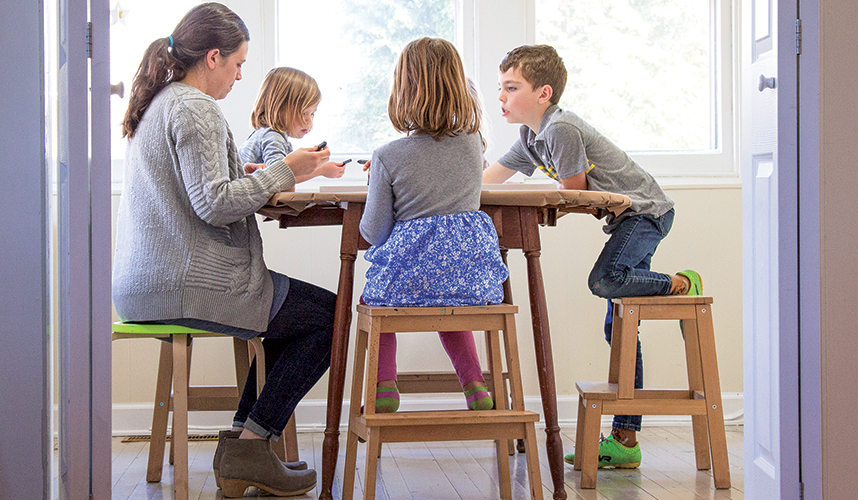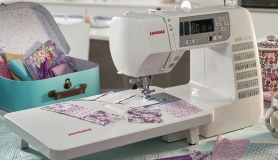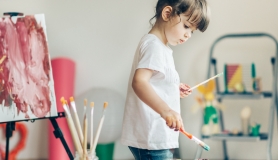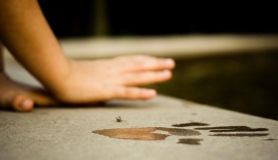When I look around our house I see the growth of my creative family over the past several years. Our small sunroom - turned-studio is filled with colourful art materials, finished artworks drying on a rack, and more than one project in progress. My daughters’ vibrant paintings hang on the walls throughout the house. I love seeing the reminders that I have said Yes! to art—emphatically and often—through my surroundings, the way I parent my daughters, and how I interact with the world.
More important than the visible reminders, though, are the connections art creates between us, the joy it adds to our days, and the creativity it fosters.
I have long used the power of creative connection to make our family’s life smoother and more fun. Activities such as art and music work well for transitions, can defuse emotional situations, bridge different ages and developmental stages, bring people together, foster self-confidence, and aid in learning about oneself and the world. This is especially true when you take an open-ended approach to encourage creative thinking, doing, and making.
HOW CAN PARENTS ENCOURAGE CREATIVITY?
We humans are born with tremendous creative potential. In the process of growing up, this creative potential can be nurtured by a child’s circle of family, teachers, and peers, as well as his or her environment. However, that potential can also be dampened. Years of education at institutions that promote rote learning or “teaching to the test” coupled with excessive screen time can be especially insidious, as both often tell children how and what to think, rather than encourage children to question and experiment for themselves. In addition, the sheer number of hours spent at scheduled activities and on screens can preclude other creative activities or the pursuit of individual interests.
SO WHAT CAN WE DO?
As parents, we must try to nurture our children’s creativity to the best of our abilities. Yes, we can choose schools carefully and guide screen time, but ultimately, we have the most influence on our children’s creativity within our own home. We have the power to build a strong creative foundation before our children reach school age. By offering an environment where it is safe to experiment and create, where questions are encouraged, and where children have free access to the materials they need and enjoy, we can use creative activities to connect with our kids while encouraging their unique interests and aptitudes. We do this not to produce career artists, but to raise children who are confident and comfortable with their creativity in whatever form it takes. And, happily, a remarkable amount of learning, habit, personality, and creativity continues to be influenced by home life even after school years begin.
ARTFUL PARENTING
I define an artful activity as any that is full of art, beauty, and creative exploration. As parents, we can make our family life more artful and creative in numerous ways. While painting, drawing, and other traditional art-making methods are obvious choices, there are many other activities to consider as well:
- Trying out new science experiments.
- Creative thinking is encouraged by the act of experimenting.
- Taking a nature walk. There is infinite beauty in the natural world. Observe the veins in leaves, clouds in the sky, the colours of flower petals, and more.
- Cooking. Preparing food together is creative, educational, and nourishing.
- Playing. Pretend play encourages imagination, whether planning a teddy bear tea party, playing house, or constructing a Lego city.
- Dancing and making music. Music and movement are ripe for open-ended exploration. Have an impromptu dance party, drum on pots and pans, or make up new words to a familiar song.
Just about any part of life is fair game for developing creativity if you approach it with an open mind and a little resourcefulness.
You can invite art into your home with your actions, words, attitude, and the activities you offer. You can do it by creating space to do art, making art materials available, and introducing new concepts and activities. You can do it slowly over time or start an overnight art revolution! No matter how you introduce art to your family’s life, the advantages are profound.
THE BENEFITS OF ART
Educators tell us that art encourages fine motor skills, neural development, and problem-solving abilities, and that it can be used effectively to teach and understand other key subjects such as reading, writing, maths, and science. Therapists tell us that art is valuable because it allows children to process their world, to deal with sometimes scary emotions in a safe way, and because it gives them critical sensory input. Artists tell us that art is important for its own sake—as a source of beauty and expression, as well as simply for the process of creating. Kids tell us that art is fun, an activity they enjoy. Parents tell us that art is vital to their families because it keeps everyone engaged and happy and helps with the sometimes difficult transitions of the day.
Art is also naturally linked to creativity, an attribute that is increasingly being touted as one of the most important factors for the success of individuals, organizations, and cultures and therefore one of the most important attributes the next generation can have. The world is changing with ever- increasing speed, and we need to remain flexible and innovative to embrace those changes and invent a better future where everyone can thrive.
The truth is that art is vital for holistic development and when children engage in hands-on art activities, it benefits them in all disciplines. Here are some of the reasons why children thrive when they make art.
ART PROMOTES CREATIVITY
Creativity is the ability to think outside the proverbial box and to string unrelated ideas together in a new way. Solutions to major problems and breakthroughs of all kinds are evidence of creativity. The ability to be creative is vital to the success of our children and the well-being of the planet, now more than ever, as we face incredible challenges in our world. Individuals, organizations, and governments seek innovative solutions every day. According to the International Child Art Foundation: “Research indicates that a child who is exposed to the arts acquires a special ability to think creatively, be original, discover, innovate, and create intellectual property—key attributes for individual success and social prosperity in the twenty- first century.” The world needs more and better creative thinkers.
“Our task, regarding creativity, is to help children climb their own mountains, as high as possible. No one can do more —Loris Malaguzzi”
ART DEVELOPS CONFIDENCE
Open-ended art, creativity, and play give kids the chance to be the experts, fostering both independence and self-confidence. They are so often told by the grown-ups in their lives how and why to do everything. With creative activities, children can be the ones with both the questions and the answers as they make their own decisions and guide their own experiences.
ART ENCOURAGES NEURAL CONNECTIONS
Art is an activity that can employ all the senses—sight, sound, touch, smell, and taste—depending on the activity. Children’s brain synapses fire away as they experiment and create, squish clay between their fingers, mix paint colours, draw pictures from their imagination, or build pipe cleaner sculptures.
ART BUILDS FINE MOTOR SKILLS
Gripping a paintbrush, drawing dots and lines, mixing colours, cutting with scissors, controlling a glue stick or squeezing a glue bottle, kneading and rolling playdough, tearing paper—all of these tasks require increasing amounts of dexterity and coordination, yet they are so fun and rewarding that children want to do them over and over. As kids engage in art activities over time, their fine motor skills improve.
SCRIBBLING IS A PRECURSOR TO WRITING
Babies and toddlers begin by scribbling randomly back and forth. The more they scribble, the more they are able to control the crayon and its movements across the paper. As children learn to control their scribbling, they make a wider variety of shapes, eventually making all the shapes necessary to write the letters of the alphabet—any alphabet.
ART DEVELOPS PROBLEM-SOLVING ABILITIES
Open-ended, process-oriented art is nothing but an endless opportunity for making choices, coming to conclusions, second- guessing decisions, and evaluating results. Children become more comfortable with un-certainty and remain flexible thinkers, which is key for creativity and confidence. And the more experience they have with a variety of materials and techniques, the more likely they are to try new combinations and ideas.
ART HELPS KIDS UNDERSTAND THEMSELVES AND THEIR WORLD
Children absorb incredible amounts of new information every day, and they need to process what they have learned in a safe, reflective way. Art allows them to explore feelings and deal with both daily and significant events. Art materials can provide a safe outlet for emotions. Feelings and ideas can be reduced to a manageable size and manipulated as desired.
Movement, image, colour, line, and imagination all help children express themselves in a multidimensional way—a way that can expand be-yond language or may be more comfortable for them than words.
When we encourage our children to explore art, we encourage them to master themselves, their bodies, and a variety of tools and techniques. We give them many ways to express themselves.
ART HELPS KIDS CONNECT
Art is an equalizer, helping create a common ground for children who don’t know each other and who may or may not be interested in the same things. It can help people of all ages, cultures, abilities, and even languages engage in a shared enjoyable activity.
EMBRACE ART AS A FAMILY
As parents, we are in the best position to nurture our children’s creative potential and build a strong creative foundation for them. In fact, I strongly believe that we have the responsibility to do this to the best of our abilities.
We want our children to cultivate their own unique, creative mindset, problem-solving abilities, and self-confidence that will continue to bloom throughout their lives. (This is much more important than getting them to create adult-appreciated art in time to win the next school colouring contest.) We also want to have fun together as a family, strengthening the bond with our children in the process.
The path to an art-filled and creative life involves an open mind, a few simple tools, a bit of preparation, and an exploratory approach. It’s a path anyone can take at any pace. Some of you will read this and meander down the path, trying out a few new ideas here and there. Others will sprint along, adopting new ideas as quickly as you read about them. There is no one right way. Pick the approach that works best for you.
Are you ready to embrace art as a family? To begin connecting through creativity by drawing, doodling, and painting side by side with your kids? In fact, I have a simple, open-ended art activity for you to start with—Scribble Art. Don’t be fooled by the name! This is an enjoyable and relaxing activity for all ages. Plus, it’s one that you can revisit anytime.
MORE INSPIRATION
READ The Artful Parent by Jean Van’t Hul (Roost Books)
11 WAYS TO BE AN ARTFUL PARENT
- Encourage open-ended exploration, period. Of everything, not just art. This includes (but is not limited to) ideas, construction, toys, art activities, music, and pretend play.
- Assume your children are highly creative (they are!) and treat them as such. Talk to them as creative beings and offer creative activities and opportunities, both those that they already love and those that stretch them.
- Model creativity. If you don’t feel creative, you know the saying— “Fake it till you make it.”
- Remember that connection is key. Set your phone down and put away your to-do list as much as possible when you are with your kids. If you’re addicted to either or both, pick up a copy of Hands Free Mama by Rachel Macy Stafford (Zondervan, 2014).
- Look at the world in new ways together. Try a new lens for viewing the details around you, such as a loupe, binoculars, a microscope, a telescope, or even a camera. Experience different viewpoints through museums, books, travel, hands-on activities, and interaction with others.
- Let your children be bored. Or at least don’t quickly jump in with a planned activity or screen time just because the kids say they’re bored. Sometimes the best creativity lies just on the other side of boredom.
- Offer creative activities, materials, and opportunities regularly. This can include strewing, art invitations, projects to do together, child-led art in their own art space, open-ended toys to play with, and more.
- Recognize that artful parenting and artful living encompass ALL aspects of life. They’re not just about doing art activities together. They’re about cooking together, gardening, reading beautiful books, chatting, playing games, going on nature walks, holding hands, connecting, and so much more.
- Celebrate the seasons and holidays throughout the year. Notice the changes in the world around you day to day, week to week, and month to month. Pay attention to the little things—birdsong in the morning, patterns of light and shadow, the scent of the flowers.
- See each child as a unique being with her own interests, learning style, and personality. Nurture her individuality, rather than expecting her to conform to who you are or who society expects her to be.
- Be the best parent you can be, and don’t beat yourself up when you fall short of your ideal. Every day—every moment—is a fresh opportunity to parent the way you desire.
SCRIBBLE ART
This simple art activity is fun, abstract, even meditative. And the results are beautiful!
For ages 3 and up
MATERIALS
- Watercolour paper card
- Black crayons or oil pastels
- Watercolour paints and brushes
INSTRUCTIONS
- First, use your crayon to fill your paper with a big scribble of overlapping and intersecting lines and swirls.
- Then, colour some or all of the shapes and sections between the scribble lines with watercolour paint. (Alternately, colour them with crayons.)







